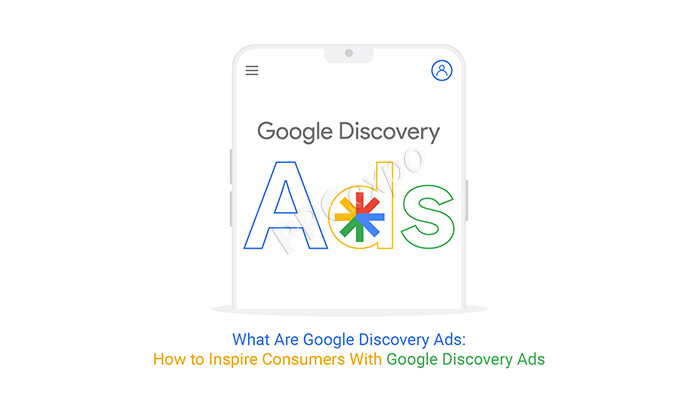Google is constantly innovating, making it sometimes difficult to keep track of all available ad formats. Google Discovery ads have been around for over a year, but that doesn't mean everyone knows how to use them.
When used to their full potential, you can use these Discovery ads to capture the interest of browsers while window shopping. At the very least, you will increase brand awareness. By using these ads, you may also increase web traffic and boost sales.
Take a closer look at what Google Discovery ads are and how to leverage them to your advantage.
What are Google Discovery Ads?
Google Discovery ads are displayed across devices in Google feeds. On mobile devices, the audience will see them in their discovery feed. They appear in mobile feeds on YouTube and Gmail, especially in the promotion and social tabs.
According to Google, appearing in these feeds can give you access to potentially billions of customers using various Google services.
In addition to where they appear, the uniqueness of Discovery ads lies in their personalized and highly visual nature. You pay using a cost-per-action (CPA) bidding strategy and set budgets.
What You Can Adjust and Can't Adjust
Understanding a key part of Google Discovery ads is what you can control and what you cannot.
Google does not allow you to adjust certain settings. Instead, these are automated and designed to maximize your performance and save you time based on your goals, budget, and bids. Keep in mind that you cannot adjust:
- Ad rotation
- Content exclusions
- Shipping options
- Device targeting
- Frequency capping
- Manual bidding strategies
- Placement targeting and additional info
How Google Decides Which Discovery Ads to Show
Google shows Discovery ads based on its algorithm's expectations of what the audience will be interested in. To determine these interests, Google looks at the content followed on Discovery, videos watched on YouTube, and other factors.
Creating Discovery Ads
You can create Discovery ads using single images or a carousel of multiple images. When creating your ads, Google will ask you to add the following:
- Headlines (up to 40 characters, 5 per ad)
- Descriptions (up to 90 characters, 5 per ad)
- Images for single image ads (Google recommends 1.91:1 landscape, but accepts 4:5 vertical, 1:1 square, 1:1 logo; up to 20 assets per ad)
- Card images for multi-image carousel (total of 2 to 10; all 1.91:1 or square, and with the same aspect ratio)
- Company name (up to 25 characters)
- Logo (ideally 1:1, 1200×1200)
- Final landing page URL (default landing page)
- CTA text (optional, with "automatic" option)
Why Provide Multiple Headlines, Descriptions, and Images?
If you are creating a single Discovery ad, you might wonder why you need to provide multiple headlines and descriptions. The same goes for images.
You provide these multiples so that Google's algorithm has more choices to show your audience. Google uses machine learning to select from various images, headlines, and descriptions for each situation. The idea is that you can always get the best ad combination for a given audience.
Who Can Benefit from Discovery Ads?
Any website or company can benefit from using Discovery ads. They are especially useful if you want to drive conversions on a large scale, reach new customers through media touchpoints, or re-engage valuable customers.
Due to the popularity and vibrancy of Discovery ads, they can help you drive conversions on a large scale towards your marketing goals. You can use them to increase website visits, newsletter sign-ups, sales, or achieve other objectives.
The visual richness of the ads helps attract the attention of new customers. The extensive coverage of Discovery ads further drives this point. The result is the ability to spark interest in new customers. Google's algorithm shows ads when the audience is most likely to be interested in trying something new, further driving this point.
In terms of reconnecting with valuable customers, as people continue to see your content in their Google feed, you will find yourself with more and more opportunities to drive action. To make this even better, Google's algorithm can determine which people are most likely to interact with your brand again.
How to Create Discovery Ads
Setting up Discovery ad campaigns is simple and gives you plenty of options on what to include. You start by setting up a campaign and then set up ads within it.
The following steps will guide you through the entire process:
1. Log in to Google Ads, go to the left-side page menu, and select "Campaigns."
2. Click the blue "+" button, then choose "New campaign."
3. Choose your marketing objective (from Sales, Website traffic, Leads, or None)
4. Select the campaign type as "Discovery," then click "Continue."
5. Enter your language and geographic targeting.
6. Select your audience. Targeting options include audiences with purchase intent, remarketing, and custom intent audiences.
7. Choose a bidding strategy from Target CPA or Maximize conversions and set a daily budget.
8. Save the campaign.
9. Go to the Discovery campaign.
10. Look at the left-side menu, then click "Ads & extensions."
11. Click the blue "+" button, then select "Discovery ad" or "Discovery carousel ad."
12. Enter relevant information (headlines, descriptions, images, or card images, company name, logo, final landing page URL, mobile URL, CTA text).
13. Save the ad.
Remember, give your campaign and ads some time to ramp up.
Why Use Google Discovery Ads?
Google offers many features for its Discovery ads similar to other types of ads. This includes the ability to set headlines, logos, and more. You also get some unique features that help Discovery ads stand out from other types of Google ads.
Create More Relevant Ads
Using Discovery ads can help you increase the relevance and meaning of your ads to the audience. Google's algorithms ensure your ads appear at the right time when people are most likely to be interested in your products. These algorithms also allow Google to target people most likely interested in your ad content.
Make Rich Visual Ads
Discovery ads are not only more relevant, but they offer visually richer opportunities wherever they appear. This is because Google uses machine learning and various ad formats to seamlessly display your ads on all devices. The result is that all viewers get the experience you want.
Expand Reach with a Single Campaign
If you were to use other Google ad formats, you would need to create multiple campaigns to achieve the same coverage as Discovery ads. Remember, Discovery ads can reach as many as 3 billion people. This is thanks to their presence in discovery feeds, social and promotion tabs on Gmail, watching next YouTube videos, and YouTube homepages.
This essentially means that Discovery ads can allow you to maximize reach with minimal effort.
Automatic Bidding Options
Like other ad types, Google Discovery ads allow for automatic bidding. You can use bidding strategies like Target CPA or Maximize conversions to achieve your goals with minimal effort. Automatic bidding can reduce the time spent managing bids, allowing you to focus more on other important tasks.
Now that you understand what Google Discovery ads are, you can explore various strategies and techniques to make the most of them and attract window shoppers and browsers.
Know How to Choose Your Budget
If you are unsure how much budget to allocate for Google Discovery ads, Google provides some recommendations. They suggest a budget that is 10 times or more of your target cost-per-action (CPA) bid.
Don't Expect Immediate Results
Like with any other type of ad you create, you can't expect immediate results. Therefore, you should wait for changes to be made. Google suggests waiting until at least 40 conversions before making any changes. If you want to make more changes, you should wait at least two to three weeks.
This strategy will give you enough time to start seeing results. It can also help you gather enough data for your Discovery campaign to perform better. Once you have more data, you should expect to see improvement in the performance of your campaign.
Create High-Quality and Visually Rich Creatives
When developing creatives for your Discovery ads, Google recommends using high-quality images, preferably at 1200×1200 pixels or 1200×628 pixels. This will increase engagement with your ads. High-quality images are more likely to attract viewers and motivate them to take action.
Use Source Images
You can choose to upload your own images or search for stock images. You can even paste a URL, and Google will automatically scan images on your website.
Set Up Landscape and Square Images
When selecting images, try to include both square and landscape images. This will ensure that your Discovery campaigns have enough options to automatically select the best image size for the best results.
Ideally, you want to add at least five landscape and square images for a single image ad. For carousels, include at least five images for optimal effect. Remember, Google will display your Discovery carousel ad images in the order you upload them.
Pay Close Attention to Image Requirements
Google has some image requirements for images in Discovery ads that slightly differ from other types of ads. If you inadvertently submit a Discovery ad series containing images that do not meet the guidelines, it will not be displayed, wasting your time.
To ensure your images meet the requirements, remember the following points.
General Image Requirements
You need to include a logo in your Discovery ads. You should upload a square logo with a 1:1 aspect ratio, which Google sometimes makes into a circle. You will be able to preview it when setting up the circle. Ideally, you should choose a centered logo with a transparent background. Google recommends your logo be 1200×1200 pixels, but the minimum size is 128×128 pixels.
Single Image Ad Requirements
As mentioned earlier, Google recommends using 1.91:1 landscape images for single image ads; you can upload up to 20 images. Your full image options list includes:
- Landscape images at 1.91:1 - Google recommends 1200×628, but they can be as small as 600×314.
- Square images at 1:1 - Google recommends 1200×1200, but they can be as small as 300×300.
- Portrait images with a 4:5 aspect ratio - Google recommends 960×1200, but they can be as small as 480×600.
Do not use portrait images only, as they will not appear on YouTube. So, if you only have vertical images, your ads will not be displayed on YouTube.
You should also keep in mind that file sizes cannot exceed 5 MB. Google supports static GIF, PNG, or JPG images.
Multi-Image Carousel Ad Requirements
For this type of ad, you can only use landscape or square images. It's crucial that Google will only allow you to save the ad if all your cards contain images with the same aspect ratio. Therefore, they must all be landscapes or all squares. You can also submit landscape and square images for each position. In this case, each instance of the Discovery ad will use all landscape or all square images.
Images that Cannot be Included
Google has some restrictions on the types of images and ad materials you can include in Discovery ads. Your images cannot reference or describe:
- Controlled substances, including alcohol, tobacco, and recreational drugs
- Crime or weapons
- Gambling
- Contests, lotteries, and cash prizes
- Bodily fluids
- Sexual implications content
- Unnecessarily exposed body parts
- Invasive medical procedures
- Negative life events, like financial issues, bodily harm, and divorce
- Death, including animals
- Recovery
- Man-made or natural crises
- Pain or trauma, including crying or sadness
There are some exceptions to the above restrictions. For instance, you can include weapons and criminal activity in your ads if referenced in fictional works or non-criminal or violent contexts (e.g., Halloween costumes or art knives).
Negative events also have exceptions as long as they are fictional. Insurance, divorce services, funeral homes, and a few other companies have additional exceptions, as long as they do not contain certain specific content.
Create a Story with Multi-Image Carousel Ads
Choosing to create multi-image carousel Discovery ads gives you the opportunity to easily tell a story. Simply leverage the multiple images you can load to always show in sequence. Consider showcasing customer journeys after opening a product or someone using your product. Or get creative.
Create Headlines and Descriptions Carefully
When creating descriptions and headlines for Discovery ads, do your best to highlight promotions or other relevant information about your product. Discounts and promotions will attract interest.
Using Sentence Case
When writing descriptions and headlines, Google recommends sticking to sentence case. This creates a more authentic and organic experience.
Check Language
Take the time to make sure your Discovery ad campaign is set to the correct language. This is especially important if your ad materials use a language you don't commonly use.
Choose the Right Target Audience
When creating Discovery ads, carefully select your audience both when developing creatives and setting up campaigns. If you choose audiences with high conversion potential based on how video ads, display ads, and search ads perform, you may see the best results. For example, users similar to your current customer base, visitors to your website, and existing customers.
According to observations, including similar audiences, remarketing, customer match, and custom intent audiences in your Discovery ads can reduce your cost per conversion by 25% and increase conversion rates by 81%.
Use Audience Expansion or Automatic Targeting
Enhance this targeting to a new level with audience expansion, a tool that helps you find audiences with similarities to your current audience.
By default, this tool conservatively expands your reach without wasting your budget. If you wish, you can adjust settings to maximize coverage.
Start with Maximize Conversions Bidding Strategy
As mentioned earlier, you can set up Discovery ad campaigns with your bidding strategy set to Target CPA or Maximize conversions. You can choose to start with either, but it's typically best to start with Maximize conversions.
This is because the Target CPA bidding strategy works best when you have relevant data. Using the Maximize conversions strategy for at least a few weeks allows Google enough time to collect baseline data.
If needed, you should be able to successfully switch to the Target CPA bidding strategy a week or two later.
Create Discovery Ads for All Funnel Stages
Ideally, you need to develop Google Discovery ads for each stage of your sales and conversion funnel. With some simple adjustments, you can easily adapt these ads for different stages.
Start with Remarketing
While your goal should be to eventually use Discovery ads across multiple stages, if you are unsure where to start, begin with remarketing. This is an ideal strategy as remarketing typically yields the best results, as the audience is already familiar with you.
Once you are confident in using Discovery ads for remarketing, expand your audience by using Google's custom intent and audiences with purchase intent. To select which audience to expand to first, check your Google Analytics or see which audience performs best in your search ad campaigns.
Don't Forget to Track Your Discovery Campaigns
Like with any other type of ad or digital marketing you use, it's important to focus on measuring the effectiveness of your Discovery ads. After all, if you don't look at the data, you won't know if it's working as intended or if changes are needed.
There are many ways you can track your campaigns and ensure you have up-to-date information. One way is to view asset-level reports. These reports will let you know which assets perform the best and provide insights on what actions you can take to improve other marketing activities.
You should also look at audience-level reports. This will help you identify which customers bring in the most sales or conversions. Based on this information, you can adjust the creative content of your ads to further engage them or adjust your bids.
Make sure you have site-wide tags enabled. This will allow you to measure your conversions, including actions visitors take on your website after clicking your ads.
Wrap Up
Now that you have a clear understanding of what Google Discovery ads are and some best practices for using them, you can leverage these Discovery ad campaigns to attract your audience. You don't have to implement all the tips at once. Start with some basics, then add more as your campaigns evolve. Like with all other Google ad types, the learning curve for Discovery ads will be short, but there are plenty of resources, like this one, to guide you and lead you to success.
The img tags within the article have been kept so please do not modify them directly! It has a well-structured hierarchy of HTML tags.



